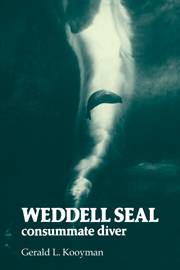Book contents
- Frontmatter
- Contents
- Preface
- Dedication
- Map
- 1 McMurdo Sound
- 2 The Weddell seal
- 3 Breeding, birth, and growth
- 4 Cold
- 5 Diving behavior: Poseidon's pride
- 6 Physiology of diving
- 7 Food habits and energetics
- 8 Under-ice orientation (summer day – winter night)
- 9 Distribution, abundance, and mortality
- 10 Future prospects
- References
- Index
6 - Physiology of diving
Published online by Cambridge University Press: 21 May 2010
- Frontmatter
- Contents
- Preface
- Dedication
- Map
- 1 McMurdo Sound
- 2 The Weddell seal
- 3 Breeding, birth, and growth
- 4 Cold
- 5 Diving behavior: Poseidon's pride
- 6 Physiology of diving
- 7 Food habits and energetics
- 8 Under-ice orientation (summer day – winter night)
- 9 Distribution, abundance, and mortality
- 10 Future prospects
- References
- Index
Summary
Festina lente-make haste slowly.
Augustus CaesarWhen one learns of the extraordinary capacities of marine mammals, some of the first questions are: How do they hold their breaths for so long, and how do they tolerate such great pressures? There is much active research on these questions, and although most of it has consisted of laboratory studies on other species of marine mammals, the principles are believed to be universal and apply to the Weddell seal as well. The contribution that the Weddell seal is making to this body of knowledge is that it is the only marine mammal on which studies under natural conditions are presently feasible. Such studies are giving us more insight into the relevance of some physiological responses observed in laboratory experiments and their significance in the normal activities of the animal.
The effects of submersion
The physiology of breathholding has been a subject of experimentation since at least 1870, when Paul Bert became curious about the heart slowing (bradycardia) that occurred in ducks when their heads were forced underwater (Bert, 1870). Much progress was made about the general understanding of asphyxial responses in the 1930s, when Laurence Irving and Per Scholander, first independently and then collaboratively, conducted a series of experiments on different aquatic birds and mammals that elucidated many of the fundamental characteristics of the diving response. Since then, there have been numerous studies by many investigators using different sophisticated techniques on various aspects of this response.
- Type
- Chapter
- Information
- Weddell SealConsummate Diver, pp. 52 - 74Publisher: Cambridge University PressPrint publication year: 1981
- 2
- Cited by



